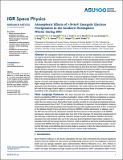Por favor, use este identificador para citar o enlazar a este item:
http://hdl.handle.net/10261/194735COMPARTIR / EXPORTAR:
 SHARE SHARE
 CORE
BASE CORE
BASE
|
|
| Visualizar otros formatos: MARC | Dublin Core | RDF | ORE | MODS | METS | DIDL | DATACITE | |

| Título: | Atmospheric Effects of > 30-keV Energetic Electron Precipitation in the Southern Hemisphere Winter during 2003 |
Autor: | Pettit, J.M.; Randall, C.E.; Peck, E.D.; Marsh, Daniel R.; van de Kamp, M.; Fang, X.; Harvey, V.L.; Rodger, C.J.; Funke, Bernd CSIC ORCID | Palabras clave: | Electron precipitation Middle atmosphere Geomagnetic storms NOx production WACCM Mesosphere |
Fecha de publicación: | 30-oct-2019 | Editor: | American Geophysical Union | Citación: | Journal of Geophysical Research - Part A - Space Physics | Resumen: | The atmospheric effects of precipitating electrons are not fully understood, and uncertainties are large for electrons with energies greater than ~30 keV. These electrons are underrepresented in modeling studies today, primarily because valid measurements of their precipitating spectral energy fluxes are lacking. This paper compares simulations from the Whole Atmosphere Community Climate Model (WACCM) that incorporated two different estimates of precipitating electron fluxes for electrons with energies greater than 30 keV. The estimates are both based on data from the Polar Orbiting Environmental Satellite Medium Energy Proton and Electron Detector (MEPED) instruments but differ in several significant ways. Most importantly, only one of the estimates includes both the 0° and 90° telescopes from the MEPED instrument. Comparisons are presented between the WACCM results and satellite observations poleward of 30°S during the austral winter of 2003, a period of significant energetic electron precipitation. Both of the model simulations forced with precipitating electrons with energies >30 keV match the observed descent of reactive odd nitrogen better than a baseline simulation that included auroral electrons, but no higher energy electrons. However, the simulation that included both telescopes shows substantially better agreement with observations, particularly at midlatitudes. The results indicate that including energies >30 keV and the full range of pitch angles to calculate precipitating electron fluxes is necessary for improving simulations of the atmospheric effects of energetic electron precipitation. ©2019. American Geophysical Union. All Rights Reserved. | Versión del editor: | http://dx.doi.org/10.1029/2019JA026868 | URI: | http://hdl.handle.net/10261/194735 | DOI: | 10.1029/2019JA026868 | ISSN: | 2169-9380 |
| Aparece en las colecciones: | (IAA) Artículos |
Ficheros en este ítem:
| Fichero | Descripción | Tamaño | Formato | |
|---|---|---|---|---|
| IAA_2019_JGR_A.pdf | 23,09 MB | Adobe PDF |  Visualizar/Abrir |
CORE Recommender
SCOPUSTM
Citations
25
checked on 21-abr-2024
WEB OF SCIENCETM
Citations
23
checked on 24-feb-2024
Page view(s)
314
checked on 26-abr-2024
Download(s)
300
checked on 26-abr-2024
Google ScholarTM
Check
Altmetric
Altmetric
NOTA: Los ítems de Digital.CSIC están protegidos por copyright, con todos los derechos reservados, a menos que se indique lo contrario.
